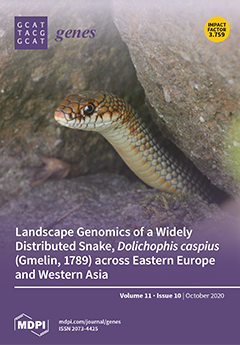Autism spectrum disorder (ASD) is a group of complex multifactorial neurodevelopmental and neuropsychiatric disorders in children characterized by impairment of communication and social interaction. Several genes with associated single nucleotide polymorphisms (SNPs) have been identified for ASD in different genetic association studies, meta-analyses,
[...] Read more.
Autism spectrum disorder (ASD) is a group of complex multifactorial neurodevelopmental and neuropsychiatric disorders in children characterized by impairment of communication and social interaction. Several genes with associated single nucleotide polymorphisms (SNPs) have been identified for ASD in different genetic association studies, meta-analyses, and genome-wide association studies (GWAS). However, associations between different SNPs and ASD vary from population to population. Four SNPs in genes
CNTNAP2, EIF4E, ATP2B2, CACNA1C, and SNP rs4307059 (which is found between
CDH9 and
CDH10 genes) have been identified and reported as candidate risk factors for ASD. The aim of the present study was, for the first time, to assess the association of SNPs in these genes with ASD in the Pakistani population. PCR-based genotyping was performed using allele-specific primers in 93 ASD and 93 control Pakistani individuals. All genetic associations, genotype frequencies, and allele frequencies were computed as odds’ ratios (ORs) using logistic regression with a threshold of
p ≤ 0.01 to determine statistical significance. We found that the homozygous genotypes of mutant T alleles of
CNTNAP2 and
ATP2B2 were significantly associated with Pakistani ASD patients in unadjusted ORs (
p < 0.01), but their significance score was lost in the adjusted model. Other SNPs such as rs4307059, rs17850950 of
EIF4E, and rs1006737 of
CACNA1C were not statistically significant. Based on this, we conclude that SNPs are not associated with, or are not the main cause of, autism in the Pakistani population, indicating the involvement of additional players, which need to be investigated in future studies in a large population size. One of the limitations of present study is its small sample size. However, this study, being the first on Pakistani ASD patients, may lay the foundations for future studies in larger samples.
Full article






